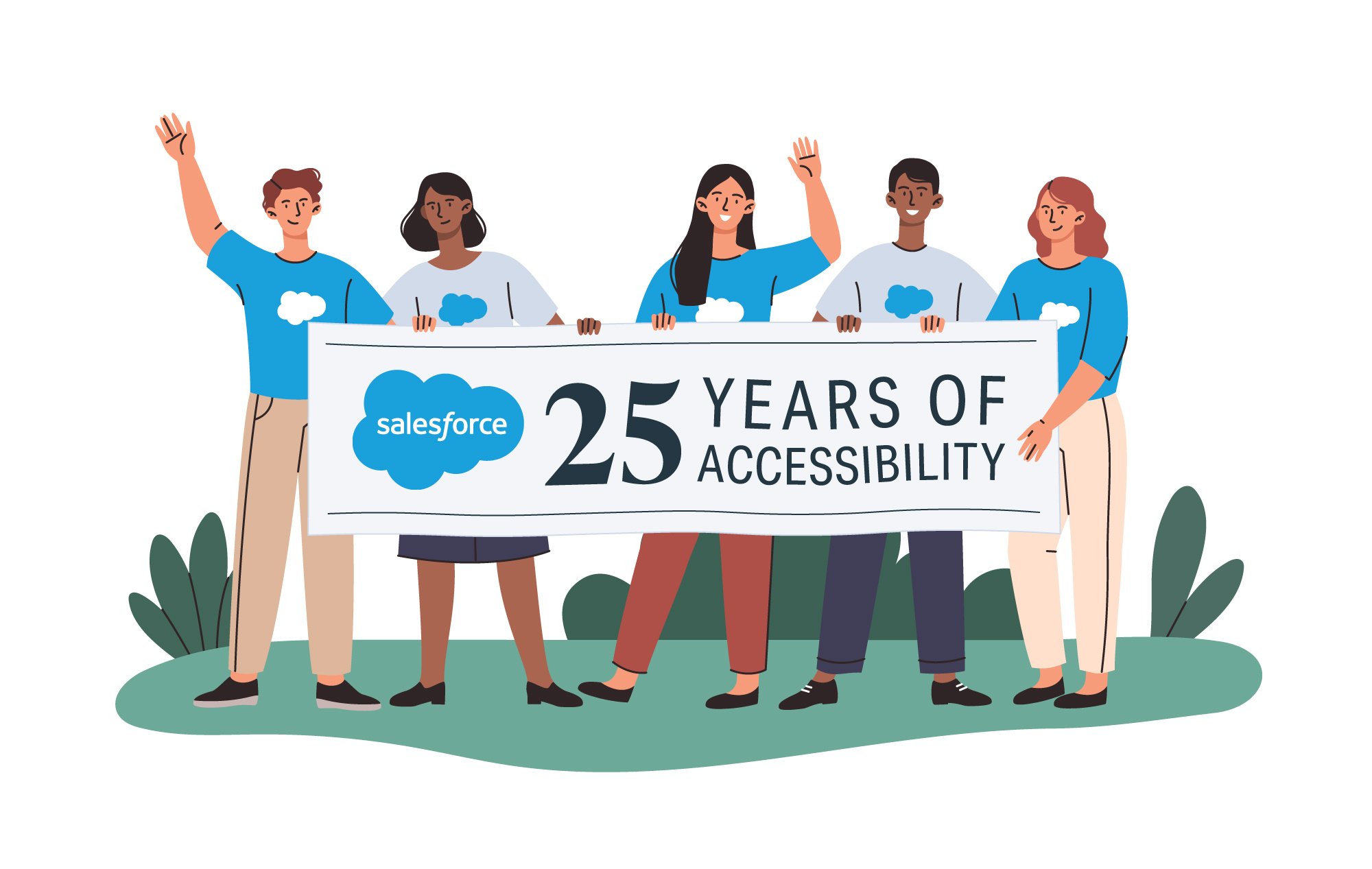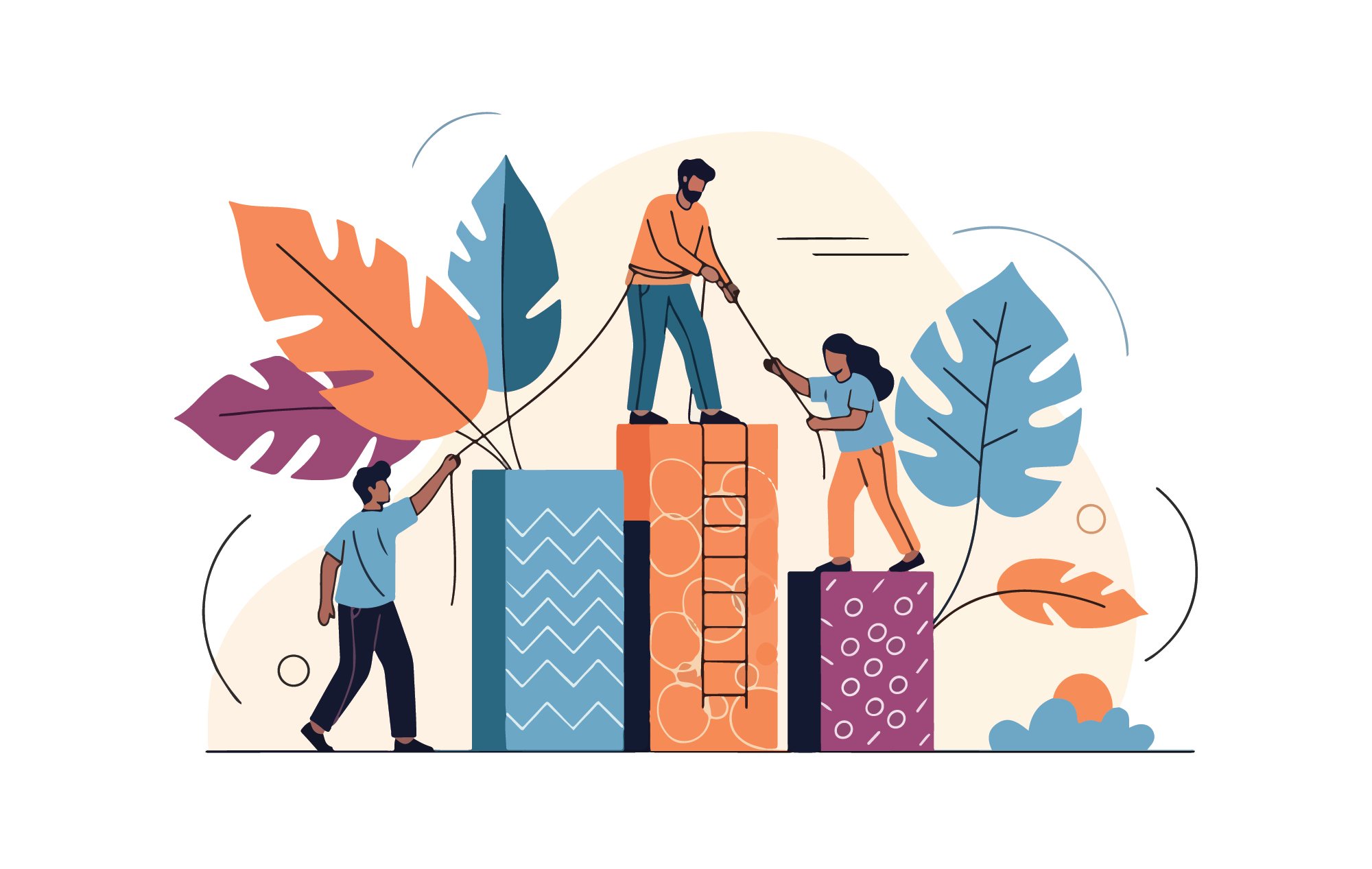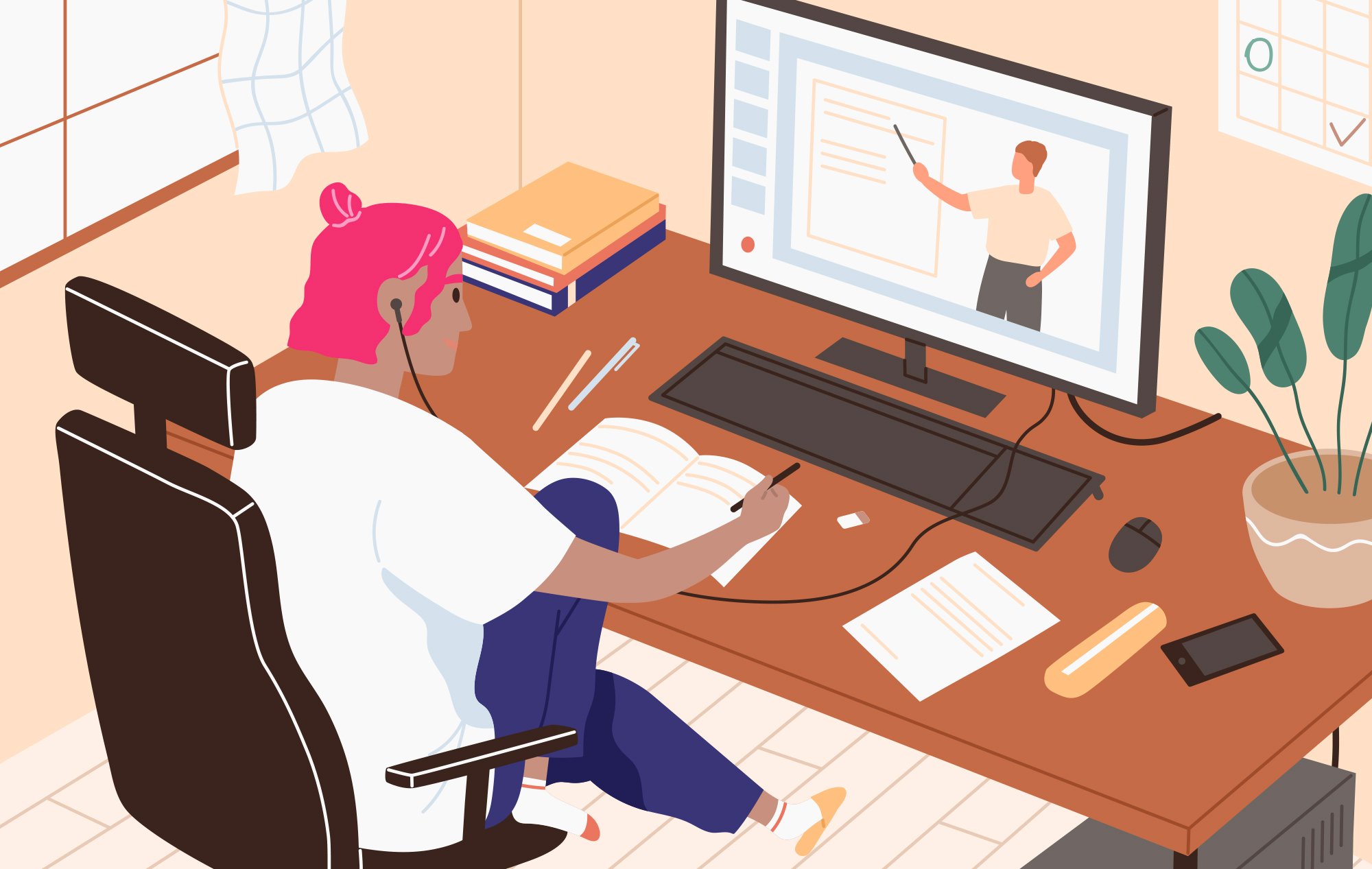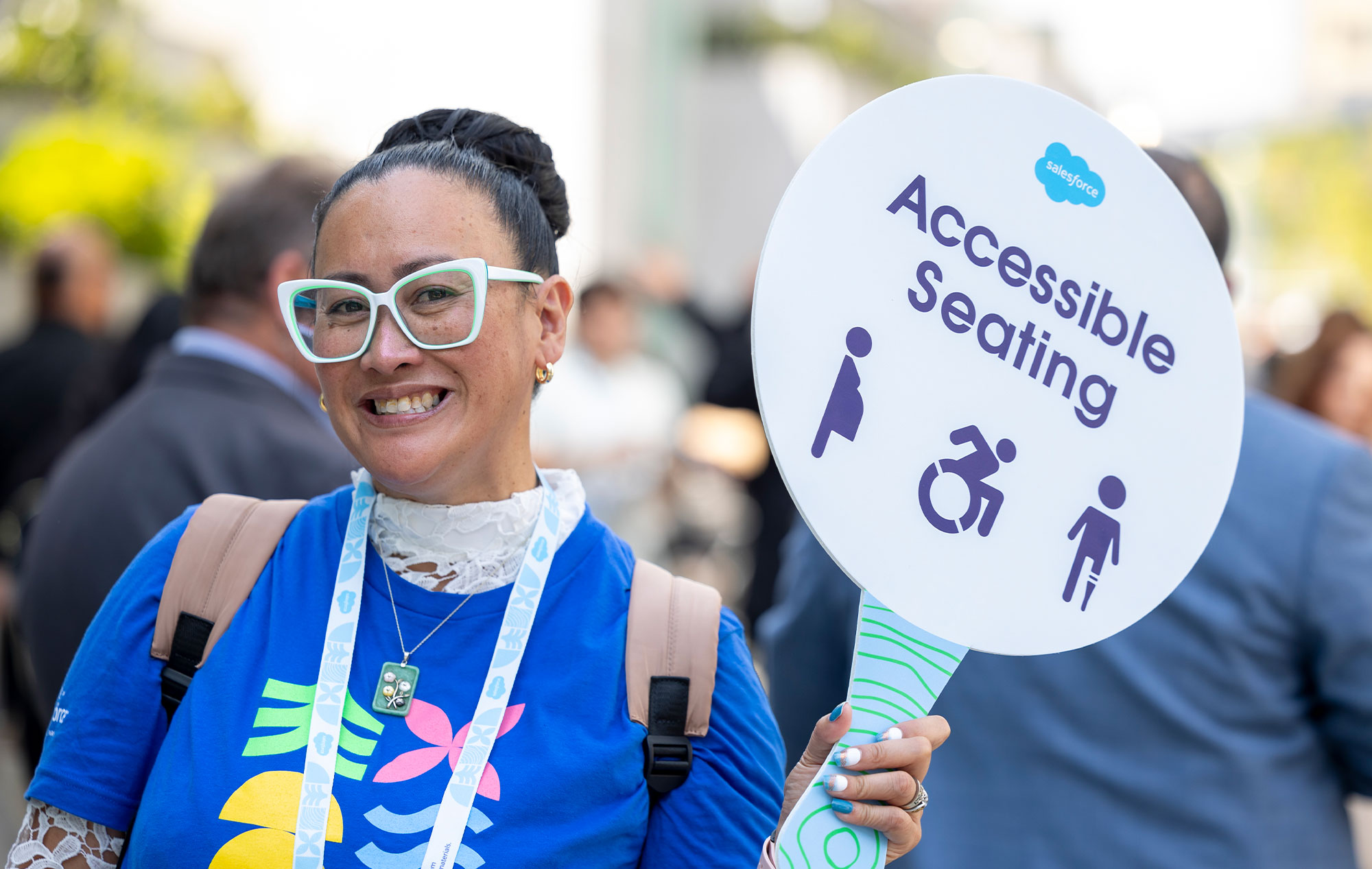An overview of this article:
- Dreamforce 2024: Salesforce is preparing for its most accessible Dreamforce event yet, building on years of progress to ensure an inclusive experience for all attendees.
- Salesforce's Accessibility Evolution: Throughout its 25-year history, Salesforce has transformed its approach to accessibility, moving from ADA compliance to becoming an industry leader in digital inclusion.
- Abilityforce & Leadership Support: Abilityforce, Salesforce’s business resource group dedicated to supporting professionals with disabilities, plays a key role in driving equality initiatives, supported by strong leadership, including the creation of the Office of Accessibility.
- Universal Design & Global Initiatives: Salesforce Tower San Francisco and global programs reflect the company’s commitment to universal design and accessibility, ensuring environments and experiences are inclusive.
- Expanding Workforce Opportunities: Salesforce’s Workforce Navigators and Disabilities @ Work programs provide mentorship, training, and global support to empower professionals with disabilities in the tech industry.
Salesforce has prepared to make Dreamforce 2024, its annual global tech conference in San Francisco, the tech company’s most accessible to date.
The cloud-based customer relationship management (CRM) software company has experienced a truly transformative accessibility journey throughout its 25-year history leading up to this year’s Dreamforce.
Let’s revisit some of the biggest accessibility developments at Salesforce across the years.
Salesforce's Accessibility Timeline
- 1999-2015: Accessibility Support Is Driven Mostly by ADA Compliance
- Early 2010s: Product Accessibility Team Is Created
- 2016: Abilityforce Employee Resource Group Becomes the "go-to" Resource for Accessibility
- 2016-2019: Real Estate and Workplace Services Uses Universal Design to Plan Salesforce Towers
- 2018: Salesforce Joins Disability:IN and Earns a DEI Score of 100
- 2019: Office of Accessibility Is Established and CEO Declares Public Support for Valuable 500
- 2020: Establishes the Accessibility Support Team
- 2020: Launches Workforce Navigators
- 2022: Disabilities @ Work Program Expands
- 2023: Salesforce Hosts Its Most Accessible Dreamforce Ever

Salesforce’s Commitment to Accessibility Through the Years
During its early years (1999-2015), Salesforce’s accessibility efforts were primarily motivated by compliance with the Americans with Disabilities Act of 1990 (ADA).
This means products and digital platforms were designed to be accessible for people with disabilities, largely based on direction from the Web Content Accessibility Guidelines (WCAG), specific standards published by the World Wide Web Consortium, and intended to make the web more accessible.
Since then, Salesforce has ramped up its accessibility efforts, establishing teams dedicated to digital inclusion, shifting accessibility to the beginning of the design process, and improving its culture to become the accessibility champion it is today.
The company established its Product Accessibility team in the early 2010s, and since then Salesforce’s efforts to advance accessibility have only increased. This has been nothing short of transformative, as Salesforce strives to become the number one employer for professionals with disabilities.
Abilityforce Is Created
Having grown from a grassroots collective within Salesforce, Abilityforce became a formal business resource group in 2016. Also known as one of Salesforce’s Equality Groups, Abilityforce aims to make the world’s third-largest software company more accessible and inclusive for people with disabilities and their loved ones.
Abilityforce also includes allies and works to create a culture where professionals feel supported and empowered to advance dialogue surrounding accessibility issues and accommodation strategies.
“We started as affinity groups,” explains Mike Raabe, current president of Abilityforce and a pricing and product operations manager at Salesforce. “We were just coming together as a community with a shared identity or vision, and then we moved into an employee resource group (ERG).”
The group has become a go-to resource for accessibility internally.
“Upon becoming an ERG the company starts offering additional resources,” he notes. “There will be money, which is always helpful, but also access to leaders that allows us to continue to grow as an Equality Group.”
Salesforce Towers Feature Universal Design Principles
Spanning 2016 to 2019, Salesforce’s Real Estate and Workplace Services planned Salesforce Tower San Francisco—now one of nine towers in cities around the world—utilizing universal design principles.
Universal design is the concept of modeling products and environments to be usable by everyone, without the need for adaptation or specialized modules—in other words, with accessibility in mind from the very beginning.
Salesforce Tower is the tallest building in San Francisco, at 1,070 feet. A public art light installation at its top consisting of 11,000 LEDs displays video animations every evening that can be seen up to 20 miles away.
This striking array has promoted many of Salesforce’s equality initiatives throughout the years. For World Multiple Sclerosis (MS) Day in 2024, for instance, it was illuminated in orange, a color important to the MS community, to coincide with several events the company was hosting to raise awareness for MS.
Matt Nesci, a customer success manager at Salesforce living with multiple sclerosis, remembers the impact the lighting had on a young family who happened to be walking around San Francisco that evening.
“They were so moved by it that they went out and took a picture,” he says, holding back some emotions. “I'm tearing up just talking about it. They took a picture of the tower and I'm like, ‘My God.’ You don't think it would have an impact like that.”
Salesforce Becomes a Part of Disability:IN
In 2018, Salesforce joined Disability:IN, a network of more than 500 corporations expanding opportunities for professionals with disabilities. Since then the San Francisco-based company has received a top score of 100 on the Disability Equality Index for five consecutive years.
Disability:IN is arguably the leading independent, third-party resource for benchmarking disability inclusion policies and programs inside corporate America. In fact, the influential network is now “trusted by more than 70% of the Fortune 100 and nearly half of the Fortune 500,” according to its 2023 index.
Each year, Disability:IN also hosts one of the largest global disability and inclusion events of the year. Salesforce has become a regular fixture at the conference, sending its accessibility team every year.
Reflecting on her 2023 experience, Lucia Rios, a Workforce Navigators associate at Salesforce, says the Disability:IN conference inspires much-needed conversations surrounding diversity, equity, inclusion, and accessibility issues that “aren’t always on the radar. So it's just really great that disability is being very invested into as well by all these other different companies.”
The Office of Accessibility Is Launched
The efforts to advance accessibility have come from both grassroots organizing and Salesforce’s senior leadership. This unwavering commitment led to the creation of Salesforce’s Office of Accessibility in 2019.
“Our Abilityforce colleagues championed these efforts through our executives,” explains Kristian Burch, Director of Accessibility Programs & Compliance at Salesforce. “[They] found the right executives to push this. And, I think, in a large corporation like Salesforce, that really is how you get the speed of execution.”
“The creation of this team started with a vision from Abilityforce,” he continues, “as well as a commitment from our support leaders.”
In particular, Salesforce President & Chief Financial Officer Amy Weaver was central in guiding the creation of the Office of Accessibility.
“From an employee's standpoint,” says Abilityforce President Mike Raabe of the Office of Accessibility’s role, “it ensures that we're receiving all employees in need of accommodations and providing them with resources. We have a fund that helps support that directly. It's making sure the real estate is accessible for not only the employees but our customers and partners—anyone that comes into our ecosystem. We want them to have a good experience.”
While Abilityforce members and employees nurture this accessibility-first culture, it wouldn’t have the same impact without the C-suite’s vocal support. Raabe believes Salesforce’s metamorphosis has been possible because Weaver is “such a big believer and proponent of accessibility and disability inclusion in the workplace.”
Senior leadership energized this momentum by simultaneously joining the Valuable 500, a call for 500 of the world’s most influential businesses to prioritize disability on their leadership agenda and end disability discrimination in the professional world. In addition to launching the Office of Accessibility, Salesforce committed to “drive thought leadership across the industry and accountability and compliance across the company,” explains Salesforce CEO Marc Benioff.
This includes commitments to:
- Grow representation of people with disabilities throughout the Salesforce ecosystem.
- Continue developing accessible products that allow all individuals to succeed in the Salesforce ecosystem and go beyond mere compliance standards.
- Promote further development of its Global Workspace Design Standards to focus on universal and inclusive design to meet the needs of all our employees and guests with disabilities.
- Extend Salesforce’s focus on improving employee and customer experiences by enhancing the accessibility of its events, internal tools, and communications to foster an inclusive environment for all.
Establishment of the Accessibility Support Team
In 2020, Salesforce forged its Accessibility Support Team, a group “that creates incredible support experiences for customers seeking to build accessible environments on the Salesforce platform,” writes accessibility expert Kristian Burch.
The Support Team has further embedded a “shift left” mentality into company culture while Salesforce has expanded the number of employees with first-hand experiences with inaccessibility issues. This means Salesforce has been able to rely on the lived experiences of those with disabilities to overcome or resolve lingering challenges users have within the Salesforce ecosystem.
Once again, senior leadership trumpeted full support for this move.
“We have an important duty to ensure every single Salesforce customer and partner gets the support they need from Salesforce,” says Jim Roth, Executive Vice President of Customer Support at Salesforce. “We’re proud to have a strong focus on equality and inclusion for our Trailblazers with disabilities. Partnering with the Office of Accessibility in this way furthers our vision of providing a support experience that is personal and effortless. We are committed to continued disability inclusion and look forward to growing this team to help our customers.”
Salesforce Rolls Out Its Workforce Navigators Program
Later that same year, the tech giant opened the doors of Workforce Navigators, a program aimed at equipping professionals with disabilities with the skills necessary to succeed in the tech world.
An estimated 1.3 billion people globally have a significant disability, according to a 2023 report by the World Health Organization. Furthermore, the U.S. Department of Labor maintains 2023 data revealing that professionals with disabilities encounter an unemployment rate of 7.7%—twice that of their non-disabled peers.
To bridge this unemployment gap and the digital divide experienced by people living with disabilities, Workforce Navigators provides mentorships, resources, and training for professionals wanting to become more proficient in technology, particularly within the Salesforce ecosystem.
“We operate in what we call a hub and spoke model,” explains Salesforce’s Sarah Mark, Program Manager of Workforce Development for People with Disabilities. “Rather than owning accessibility in product, we aim to influence all aspects of the company. We're trying to impact every aspect of a career seeker’s journey on their way to becoming a Salesforce admin or developer.”
In addition to furnishing professionals with skills, Workforce Navigators tries to keep participants’ expectations tempered. Many inaccessibility barriers and discriminatory attitudes persist within the tech world.
“At the point where people are ready for employment, they're facing potential bias and discrimination in the employment area itself,” Mark continues. “We're quite candid with folks as they're coming into this. We say, ‘We know you can do this. We know that there is a career on the other end. We know that just because you have a certification you're not going to have a job right away.’”
It’s realities like this that drive Salesforce to make internal changes and push for transformations throughout its expansive network of business partners and third-party vendors.
Disabilities @ Work Further Invests in Professionals With Disabilities
A mentorship program unveiled in 2022, Disabilities @ Work is a more targeted investment in professionals with disabilities, primarily providing coaching and peer-to-peer connections. This includes a partnership with PurpleSpace, a networking and development hub for disabled professionals, resource group leaders, and their allies.
Salesforce launched this program, in part, in recognition of the importance in taking a global approach to inclusion and accessibility. The international company knew it had to think more intentionally about those outside of the United States.
In 2023, Salesforce concentrated on improving the cultural and business practices of six countries: France, Germany, Italy, Japan, Spain, and the United Kingdom. These efforts orbited around four pillars: increasing disability representation, empowering people managers, enhancing accessibility solutions, and elevating the overall employee experience.
The Most Accessible Dreamforce to Date
Each year, Salesforce has pushed to make Dreamforce, its annual event, more accessible and inclusive than the previous.
Dreamforce features more than 1,200 keynotes, sessions, workshops, and demos showcasing innovative product launches, world leaders, product experts, and AI visionaries.
Previous accessibility efforts have included:
- ASL Interpreters
- Closed Captioning
- Low-Friction Turf
- Non-Slip Stools in Restrooms
- Electric Scooters
- Accessible Seating
- Low-Sensory Spaces
- Accessibility Track - a Sequence of 10 Sessions Dedicated to Inclusion & Accessibility Issues
“We want to empower everyone to participate in all that Dreamforce has to offer—without barriers,” said Catherine Nichols, Vice President of the Office of Accessibility at Salesforce, about Dreamforce 2022.
At Dreamforce 2023, Salesforce also provided a comprehensive Accessibility Guide with nine breakout sessions focused on disability inclusion.
This year will build upon previous initiatives, expanding its approach and understanding of what it means to be accessible.
With more than 180,000 people typically attending, Dreamforce has to account for quite a range of disabilities. Registrants are encouraged to include any accommodation requests when registering. Members of Salesforce’s Accessibility Support Team will then follow up with individuals to gather more information and coordinate a solution.
Dreamforce 2024 participants living with disabilities can anticipate numerous accommodations, including, among others:
- Mobility Device Charging Stations
- Sighted Escorts & Other Accessibility Staff
- A Quiet Space Designed to Alleviate Sensory Overload & Offer Relaxation
- Guided Tours to Assist With Finding Key Locations
- Accessible Shuttles Between Buildings
- Meals Mindful of Food Allergies and Sensitivities
There’s a long way to go in reshaping the tech industry to be more accessible and inclusive. People with disabilities deserve better.
Salesforce has experienced quite the accessibility journey throughout the past 25 years, with many more ups than downs, and remains committed to helping resolve inaccessibility in the professional world far into the future.
Salesforce is a founding partner of InclusionHub, a resource for digital accessibility dedicated to helping businesses prioritize digital inclusion. Learn more about Salesforce’s history by visiting Salesforce’s a11y website.






Leave a Comment